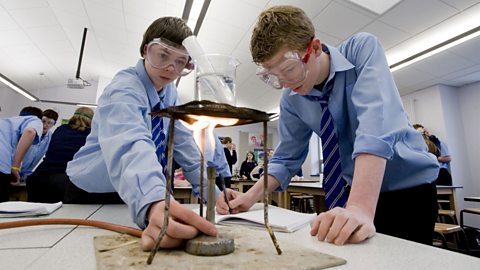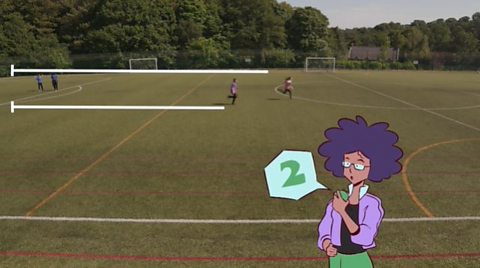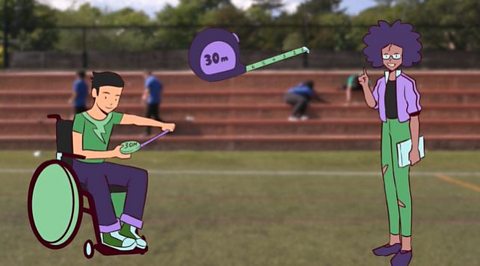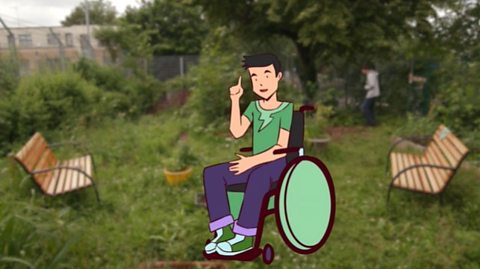Key points
- Developing a method is an important part of planning an investigation.
- In an experiment, evaluate the validity of the steps leading up to the conclusion for it to be valid.
- Random and systematic errors can contribute to the uncertainty of a measurement.
What is the name of a set of instructions that is followed when doing an experiment?
A method.
Video
Watch this video on how writing a scientific method helps to get the correct amount and quality of data.
While you are watching, look out for the difference between types of errors that can happen.
Presenter 1: In this film, we are going to look at how to plan an experiment, focusing on how to reduce errors to get accurate results. This is important because without accurate results, our experiment wouldn't be valid.
Presenter 2 : We are looking at how you might investigate how temperature affects the rate of dissolving. To do this, we need to compare how fast sugar dissolves in water at different temperatures, heated by a Bunsen burner.
Presenter 1: We will keep some things the same, the volume of water and the mass of sugar. These are the controlled variables. We will change the temperature of the water. This is the independent variable. We will measure the time taken to dissolve the sugar.
Student 1: That was quick!
Presenter 2: Hold on! I think they may have forgotten to zero the scales.
Presenter 1: Errors which cause the results to differ from the true value by a consistent amount each time are called systematic errors. Accurate results are close to the actual value.
Presenter 2: Stop! Now you're introducing random errors. Measurement should be taken from eye level. And appropriate equipment should be used to get precise results in exactly the same way every time.
Presenter 1: Random errors are often caused by measuring incorrectly, such as reading the scales the wrong way. This type of error makes individual readings inaccurate. Measuring the temperature, we need to focus on accuracy and precision.
Presenter 2: Experimental technique, like reading at eye level or using a digital thermometer, will give accurate results more often.
Presenter 1: Precise results are results which are close together. If you repeat a reading five times and get similar values, your results are precise.
Presenter 2: Repeat readings and taking the mean value will also reduce the effect of random errors.
Student 2: There you go.
Student 1: How much time?
Student 2: 1:42.
Presenter 1: The more readings you can take, the closer your mean value will be to the true reading.
Presenter 2: So, now, we have looked at ways of reducing different types of errors to help us achieve more accurate results when planning our experiment.
Writing a method
Scientists need to be able to clearly show how they carry out experiments and what they find out. When this is done properly, other scientists can check their work to find strengths and weaknesses with the experiment.
A methodA description of how an experiment should be done, often written as a list of instructions. describes how an experiment is carried out. It should contain a set of written instructions with numbers or letters to show the order in which the steps are carried out.
A diagram can be included to show how the experiment should look when it’s set up.
Each step should describe one action during the experiment. The apparatusPieces of equipment. used should be described, using scientific terms. Everything that was done to complete the whole experiment should be listed in the method, so somebody else could follow it and get a similar outcome.
Here is an example method for heating different volumes of water using a Bunsen burner.

- Make sure there are no breaks or holes in the gas hose.
- Put the Bunsen burner on a heat-resistant mat, making sure it isn’t near the edge of the bench.
- Position a tripod over the Bunsen burner.
- Put a gauze on top of the tripod.
- Put a beaker containing the required amount of water on the gauze.
- Ensure the air hole of the Bunsen burner is closed.
- Hold a lit splint 1-2cm above the top of the barrel of the Bunsen burner.
- Turn on the gas at the gas tap, and the Bunsen burner will burn with a yellow flame.
- Extinguish the splint and place it on the heat-resistant mat.
- Turn the collar of the Bunsen burner so it’s burning with a blue flame.
- Using a stopwatch, time how long it takes for the water to boil.
- Stop the stopwatch when the water is boiling.
- Close the air hole so that the flame is yellow.
- Switch off the gas at the gas tap.
What can be used alongside a list of numbered instructions in a method to make the experiment clearer?
A diagram.
Accurate and precise data
The measurements that are taken in an experiment are called data. It is important to collect data that is accurateResults are accurate if they are close to the true value. and preciseResults are precise if they have been repeated and are similar..
Accuracy is how close a measurement is to its true valueThe result that would be obtained in an ideal measurement or experiment, totally unaffected by errors.. To make sure data is accurate, calculate a meanAn average of a set of data found by adding together all the values in a data set and dividing by the number of values in the set.. Make sure that outliersResults that are very different from the others. are not included in the calculation.Precision is how close repeat readings / measurementsTaking another measurement or observation of the same experiment. are.
If repeat measurements are similar, the data is said to be repeatable dataGetting results that are similar when the experiment is done again..If someone else does the investigation and gets similar results, the data is said to be reproducible dataGetting results that are similar when someone else does the experiment..
If results are repeatable and reproducible, it can help lead to valid measurementA measurement is valid if it measures what it is supposed to measure. conclusions. Valid conclusions are drawn from valid data.
What word is used to describe a result that is close to its true value?
Accurate.
A step-by-step guide on planning an experiment

Image caption, Plan an experiment well to get accurate and precise data. Without good quality data, conclusions won't be meaningful.
Image caption, STEP 1 – Asking the question
Include the question that needs an answer. A hypothesis can help answer the question too.
Image caption, STEP 2 – Identifying variables
Identify the independent and dependent variables, including a list of variables to control and how this process will be done.
Image caption, STEP 3 – The prediction
Make a prediction - Say what will happen and why.
Image caption, STEP 4 – Equipment
List the scientific equipment needed.
Image caption, STEP 5 – Method
Make a numeric list of how equipment will be used to collect accurate and precise data.
1 of 6
True or false?
If an experiment is planned well, the data produced after following the method is more likely to be precise and accurate.
True.
Types of error
Errors can happen when taking a measurement, usually leading to a spread in data. There are two types of error that affect scientific measurements: random errorSomething that causes an unexpected difference between a measurement and the true value. and systematic errorSomething that causes results to differ by the same amount each time. .
Random error
This can alter the spread of data and cause outliers, as some measurements may be affected and not others. This can happen when equipment isn't used properly or a reading is taken incorrectly during measurements.
An example of this is Parallax errorError caused by looking at an object at an angle that causes readings to be incorrect.. This is caused when a measurement is not taken at eye level. The reading recorded can end up being too high or low.
Systematic error
This can make measurements less accurate. It may happen if equipment is not used properly and can cause each result to differ by the same amount.
Examples of systematic error include not resetting a mass balance to zero and measuring from the end of a ruler instead of from zero.
Name the two types of error that can happen during an experiment.
Random and systematic error.
Test your knowledge
Quiz - Planning an experiment
Play the Atomic Labs game! gamePlay the Atomic Labs game!
Try out practical experiments in this KS3 science game.

More on Working scientifically
Find out more by working through a topic
- count5 of 11

- count6 of 11

- count7 of 11

- count8 of 11
